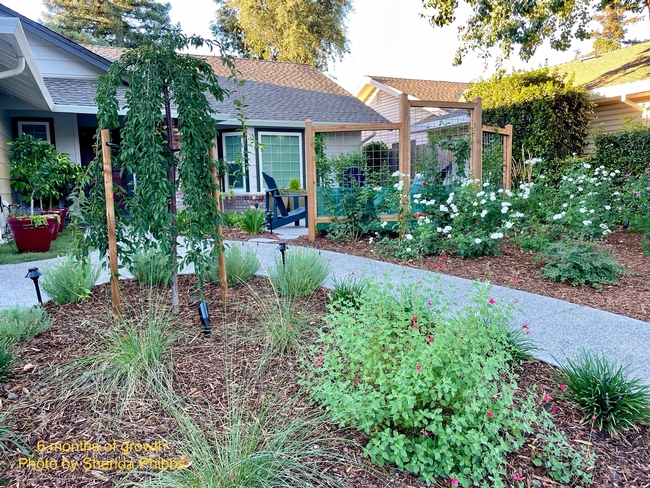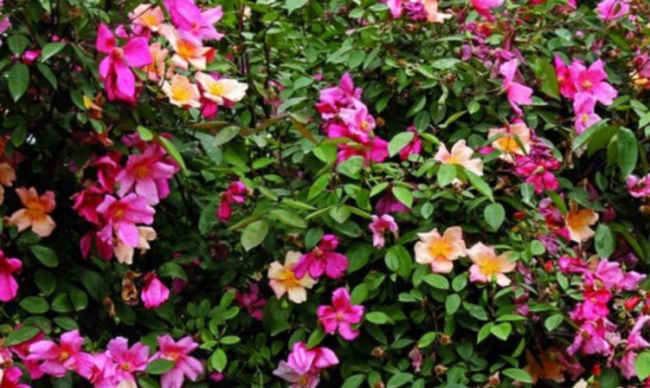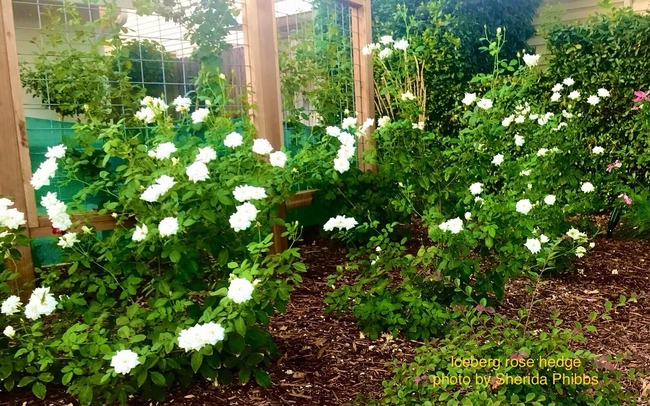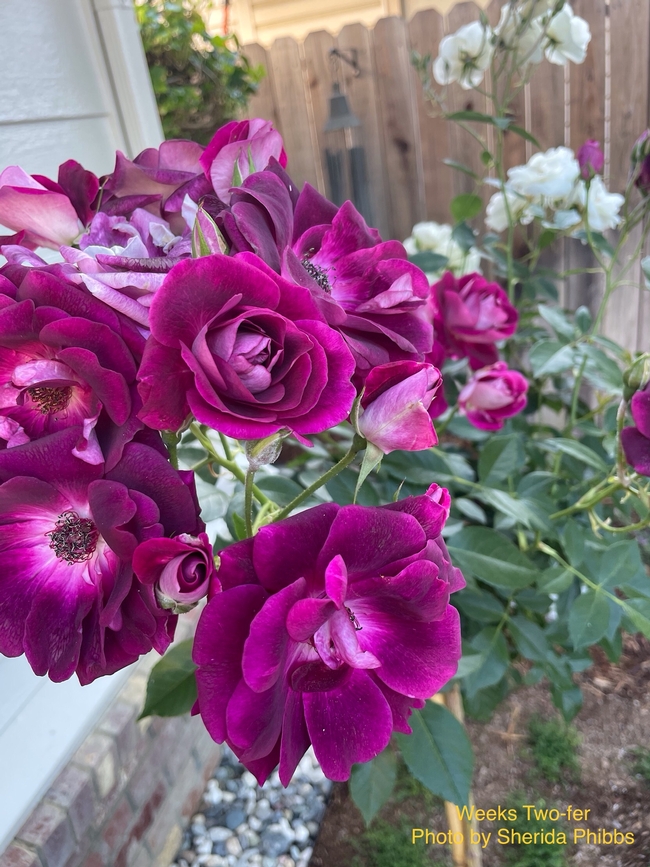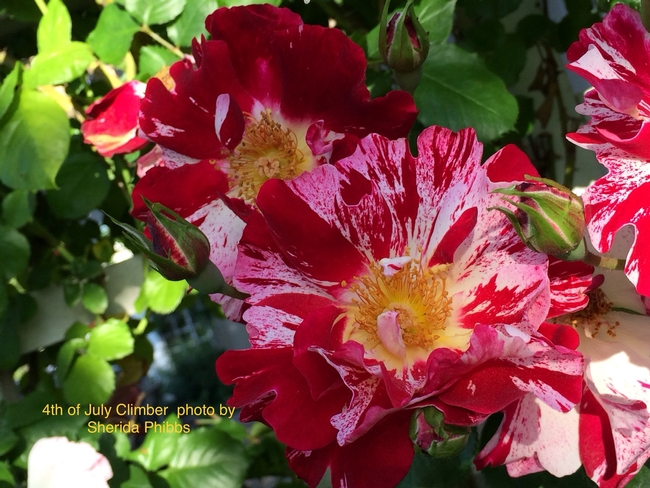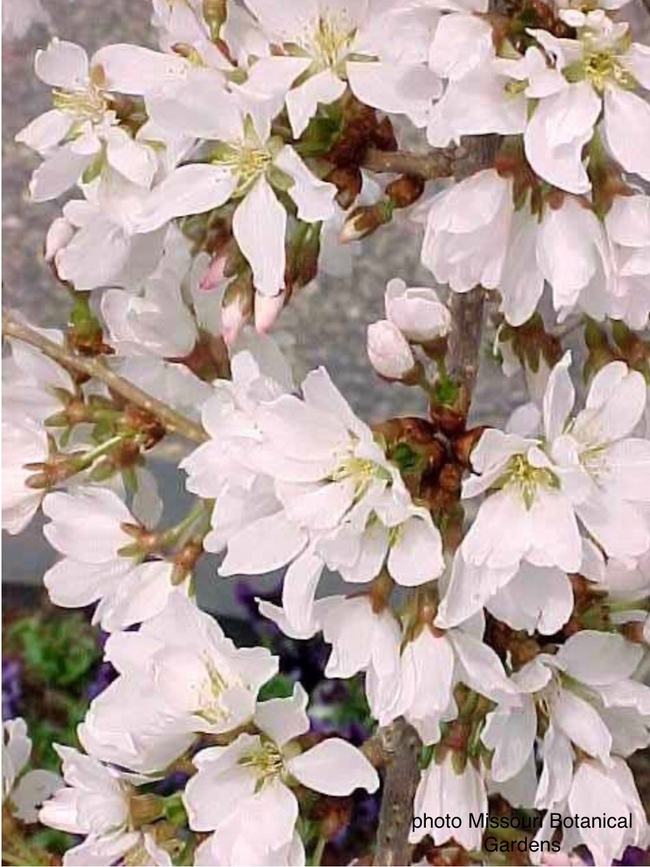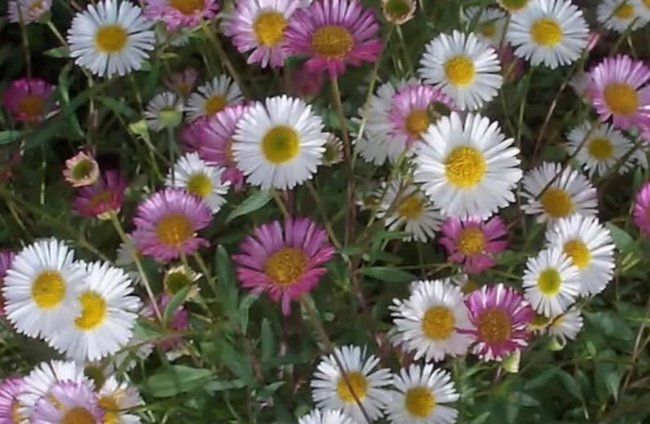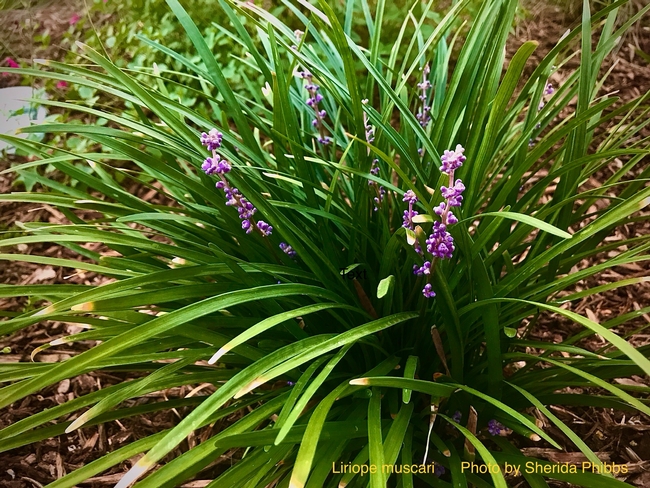Watching the transformation of my front landscape over the past six months has been nothing short of exhilarating. Despite the challenges of an exceptionally hot summer, the plants have thrived, slowly acclimating to their new environment. This success underscores the wisdom behind the Master Gardeners' mantra: “Right Plant, Right Place.” Each plant's resilience is a testament to thoughtful selection as well as careful placement and cultural care. If you missed Part One of my landscape transformation journey you could catch up here.
Follow along with me in this article as I share my simple, weekly, 15-minute maintenance routine, summer pruning benefits for select plants, and the significant benefits of choosing the right irrigation controller. I'll also showcase some of the plants I have chosen for my landscape.
The Myth of Maintenance-Free Landscapes
It's a common misconception that a “maintenance-free” landscape exists. Whether it's questions we receive at the Master Gardener Help Desk or posts on social media, a landscape that requires no upkeep is a frequent request. However, the reality is that no landscape is truly maintenance free. Even something as simple as a cement pad needs regular care—removing leaves and debris, managing weeds that sprout through expansion cracks, and more. A gravel bed, too, requires attention.
As I drive through neighborhoods, I admire landscapes that are well-maintained, reflecting the care and effort invested in them. Conversely, it's disheartening to see landscapes where significant time and money were clearly spent, only for them to fall into neglect. I often wonder when I see a neglected California native landscape if the property owner was misled, thinking that California natives are maintenance free. I highly recommend evaluating the time and the funds it will take to maintain the landscape before embarking on a new installation, and researching the chosen plants to become familiar with their upkeep requirements.
Morning Rituals for a Pristine Landscape
In the cool mornings, before the heat of the day sets in, I make it a habit to stroll through my garden at least once a week. This routine allows me to visually inspect my plants, ensuring the irrigation is properly adjusted and any potential pest issues are promptly addressed. I take this time to pluck out any tiny weeds that have surfaced—they're easy to remove when small, before their roots take hold. I also deadhead spent blossoms to encourage new growth and keep the garden looking vibrant. For unwanted insects, a simple hosing off with water usually does the trick.
I carry a lightweight collapsible garden trash container, which makes it easy to gather any debris or leaves that have blown into the landscape and to discard the spent blossoms I deadheaded. My cordless small blower is perfect for quickly clearing the porch and sidewalks. All of this takes less than 15 minutes because I stay on top of it regularly.
Summer Pruning Benefits Select Plants
Various plants in my landscape benefit from a summer pruning. By incorporating summer pruning into your gardening routine, you can enjoy a more vibrant and healthy landscape. Summer pruning reduces the risk of fungal diseases by allowing better airflow through the plants and keeps your garden looking neat and well maintained. Pruning encourages plants to produce new, healthy growth, which can lead to more flowers and a more vigorous appearance.
Summer pruning can be highly beneficial for a variety of plants in your landscape, including salvias, Santa Barbara daisies, lavenders, and creeping thyme ground cover. Here's a more detailed look at the benefits for each:
Salvias – All my salvias grew three times their size after planting. I remove one-third of the size during summer pruning. Pruning salvias after their initial bloom can stimulate a second round of flowering, while regular pruning helps maintain a compact and bushy shape, preventing the plant from becoming too leggy. Removing spent flowers and stems can improve air circulation, reducing the risk of disease.
Santa Barbara Daisies – For the summer pruning, I pruned them back quite a bit. Cutting back spent flowers encourages continuous blooming throughout the summer. Pruning helps manage the plant's spread, keeping it from overtaking other areas of your garden. Regular trimming keeps the plant looking tidy and well maintained.
Lavenders – After they bloom, I cut back the lavenders to 3 inches above the wood. It is important not to allow the plant to become woody. Pruning after flowering encourages the plant to grow more densely, preventing it from becoming woody. Pruning can sometimes lead to a second bloom later in the season. Keeping the plant's shape neat and compact helps it stay healthy and attractive.
Creeping Thyme Ground Cover – Using cordless shears, I run the shears over the top of the ground cover, removing the spent flowers and steams encroaching onto the sidewalk. Pruning helps the thyme spread more evenly and densely, creating a lush ground cover. Regular trimming keeps the stems from becoming too woody and unproductive. Removing spent flowers can encourage more blooms and a longer flowering period.
Maximizing Efficiency with Irrigation Controllers
Incorporating an irrigation controller is a significant time saver and essential for the success of your plants. Let's face it—plants are expensive, and investing in their care is crucial. With a variety of irrigation controllers available, I opted for ones that I could control via my smart phone or tablet. I have two separate controllers—one for the front landscape and one for the back. This setup was more cost-effective than paying for labor to run extensive wiring.
My smart Wi-Fi models automatically adjust to weather conditions and the specific watering needs of my plants. As a bonus, I was able to apply for a rebate from my city since they are water-saving devices. Interestingly, while the controller I selected for the front landscape is highly regarded and came with a hefty price tag, I found the less costly controller in the back landscape to have the most user-friendly app.
If you're considering replacing or installing an irrigation controller, I recommend looking for a smart Wi-Fi model and checking with your local city water department to see if rebates are available.
Curating My Garden: Plant Selections
As a plant lover, I wanted to create a garden that not only thrives in my climate and microclimate but also brings me joy on multiple levels throughout the year. I carefully selected plants that offer beauty, fragrance, movement, and texture, while also attracting and supporting pollinators. There's something magical about watching bees become intoxicated with the lavender or seeing hummingbirds flit among the salvias and other blooms.
Now, I'm excited to share the details of my plant choices with you, both in this article and in the upcoming winter and spring newsletter editions.
Roses - Timeless Beauties: Roses are an essential element of my garden's tapestry. In the expansive landscape of my Lodi country home, I nurtured a collection of approximately 200 roses. However, urban living at my city residence imposes a limit, allowing for only a select few to grace my front and back landscapes. Among these chosen few for the front landscape are one Rosa x odorata 'Mutabilis' (Butterfly Rose), six pristine white Rosa 'Korbin' (Iceberg Rose), three Rosa ‘Wekroalt' Fourth of July climbers, and two rose standards. For all my roses, I deadhead weekly to encourage reblooming and prune in February.
Rosa xodorata ‘Mutabilis', commonly known as the butterfly rose, is a cherished old garden shrub rose with a rich history. It originated in China and was introduced to Europe in the 19th century. It was first introduced to horticulture in 1934. It is a popular choice for gardens due to its floriferous nature and resistance to pests and diseases. I selected to use the ‘Mutabilis' in my landscape as a specimen rose. It's a shrub rose with the mature size of three to six feet in height and a spread of two to five feet. It has a long bloom period from spring through fall and it attracts butterflies. Its clusters of single cupped flowers are slightly fragrant. A shrub in full bloom will display a wide spectrum of color, a living kaleidoscope. It opens in yellow, changing to pink and finally a deep pink. I sourced my specimen from the UC Davis Arboretum. It is an Arboretum All Star.
Rosa ‘Korbin', commonly known as the Iceberg rose, is a popular floribunda rose cultivar. It was developed by Reimer Kordes in Germany in 1958 and is known for its ruffled, double blooms that can reach up to two to four inches in diameter. The flowers bloom from spring through fall. This rose is appreciated for its fragrance and is often used as a hedge or specimen shrub in gardens. It is also noted for attracting butterflies and birds due to its nectar-rich flowers. The Iceberg rose, a result of a cross between the R. ‘Robin Hood' in R. ‘Virgo', is recognized for its upright, well-branched growth habit, reaching heights of three to five feet and widths of two to three feet. It is listed as a UCD Arboretum All Star.
I have three varieties of ‘Korbin'.
- The classic white Iceberg, forming a hedge of six.
- ‘Brilliant Pink Korbin'. I have one specimen in my backyard. This cultivar has deep pink flowers and fades to a light pink.
- Weeks Roses Two-fer Burgundy Iceberg and White Iceberg 36-inch Standard. I have two standards with 2 rose varieties (a Burgundy Iceberg and a White Iceberg) grafted on a 36-inch Dr. Huery rootstock. A rose standard, also known as a tree rose, is a type of rose that is cultivated by grafting one or more rose varieties together to produce a tall plant with long stems. This method combines the best elements of a strong root stock, a tall stem and the desired flower color and production.
Rosa ‘Wekroalt' Fourth of July climber, introduced by Tom Carruth and Weeks Wholesale Rose Grower in 1999, is an All-American Rose Selections winner. Its red and white semi-double flowers, with golden stamens, sparkle like fireworks. With a moderate apple and rose scent, the bloom spans two inches in diameter. This vigorous climber can soar from 43 inches to 15 feet in height and spread 26 inches to 6 feet wide. It is a disease-resistant variety with glossy foliage, blooming in flushes from spring through autumn. It is my husband's favorite and I'm training three specimens to ascend our privacy screen, securing the growing canes weekly to the screen.
The Ornamental Cherry Tree - A Springtime Crown Jewel: I chose the Prunus 'Snofozam' Snowy Mountain variety for my weeping cherry tree and use an up light to spotlight it in the small island section of my front landscape. Once it matures, this tree will transform the space into a serene and picturesque haven. Its gracefully weeping branches, adorned with snow-like blossoms, will create a breathtaking spectacle each spring, heralding the season's arrival with elegance and charm. This ornamental cherry tree is not only celebrated for its stunning floral display but also for its compact size, making it a perfect fit for smaller garden spaces. In early spring, the ‘Snofozam' adorns itself with pure white flowers, transforming the tree into a vision of a snowy mountain. The effect is so complete that from a distance, it appears as though the tree is covered in a layer of snow. The flowers are not only a visual treat but also emit a subtle fragrance, adding another layer of sensory delight. Following the floral fanfare, the tree produces small, sparse, black fruits that are inedible but add an ornamental quality to the tree, as well as provide a treat for birds. The leaves are a lush dark green throughout the growing season and transition to shades of gold and orange in the fall, providing year-round interest.
Unfortunately, while I do not have pictures in bloom at this time, there are some beautiful pictures on the Missouri Botanical Gardens Website. This ornamental cherry tree is a cultivar celebrated for its weeping form and stunning floral show. Its cascading branches create a poetic silhouette that dips all the way to the ground, reminiscent of a fountain—hence its nickname, Snow Fountains®.
The ‘Snofozam' thrives best in moist, moderately fertile, well-drained loams and requires full sun for optimal flowering. While it tolerates light shade, the most abundant blooms are produced when the tree is planted in a sunny location. Pruning is minimal and typically done after flowering to maintain its shape and health. Its disease and insect resistance make it a hardy choice for gardeners looking for a low-maintenance yet show-stopping tree.
Erigeron karvinskianus - A Dainty, Versatile Bloomer: The Santa Barbara daisy is a UCD Arboretum All Star. I chose 12 Santa Barbara daisies, also known as Erigeron karvinskianus, to line the front of my landscape to soften the rock edging that prevents the bark mulch from washing out. Santa Barbara daisies are low-growing, herbaceous perennials that form a dense mat of small, narrow, gray-green leaves. They produce an abundance of small, daisy-like flowers that start white and gradually turn pink and then purple, creating a lovely two-tone effect. These flowers bloom from spring through fall, attracting butterflies and other pollinators. They grow 15 to 20 inches in height and can spread 2 to 3 feet, making them an excellent ground cover. They thrive best in full sun but can tolerate some afternoon shade. Once established, they are somewhat drought-tolerant but appreciate moderate watering. Keep the soil moderately moist, especially during hot, dry periods. They benefit from a summer pruning to encourage continuous blooming and an early spring pruning to maintain shape and encourage new growth. They are generally pest-free and are considered a great low-maintenance choice.
Liriope muscari - A Graceful Evergreen Late-Summer Bloomer: Seven Liriope muscari, also known as lilyturf, edge a section of my garden. Liriope muscari is a versatile, low-maintenance perennial that adds texture and color to gardens. They form dense clumps of grass-like green foliage with spikes of purple, lavender or white flowers in the late summer. They typically grow 9 to 18 inches tall and spread 12 to 24 inches wide. They prefer partial shade but can tolerate full sun with afternoon shade. Once established it is relatively drought tolerant. If needed, prune during the early spring, cutting back old leaves to encourage new growth. Divide clumps every few years to maintain their vigor. They are generally pest-free and not prone to serious diseases. They are ideal for edging paths or borders, or as a ground cover to prevent soil erosion.
Coming Up in My Next Article
Continue on this journey as we transition into the winter season. In my upcoming article, I will delve into the remaining plant selections that have made it into my garden. I'll provide detailed insights into why I chose these particular plants and how they fit into the overall landscape design.
Additionally, I'll share the challenges I faced during the autumn months and how I overcame them. You'll get a behind-the-scenes look at my maintenance routine, including tips on winterizing your garden, protecting delicate plants, and ensuring everything thrives despite the upcoming winter chill.
Stay tuned for practical advice, personal anecdotes, and a glimpse into the ongoing evolution of my garden. Let's embrace the beauty and resilience of seasonal gardening together!
Photo Credits and Links to Resources:
Part 1 - Transforming Your Landscape
Various Landscape Photos by Sherida Phibbs
Rosa x odorata ‘Mutabilis'
UC Davis Arboretum Picture and Plant Information
Rosa ‘Korbin'
UC Davis Arboretum Plant Information
Weeks Two-fer Burgundy Iceberg & Iceberg Standard Plant Information
Rosa ‘Wekroalt' Fourth of July
Missouri Botanical Gardens Plant Information
Prunus 'Snofozam' Snowy Mountain Prunus ‘Snofozam' Snowy Mountain
Photo Credit – Missouri Botanical Gardens
Monrovia Picture and Plant Information
Missouri Botanical Gardens Pictures and Plant Information
Erigeron karvinskianus Santa Barbara Daisy
UC Davis Arboretum plant information
Sacramento Master Gardener Video Pruning
Liriope muscari
North Carolina Extension plant information
Missouri Botanical Garden plant information
